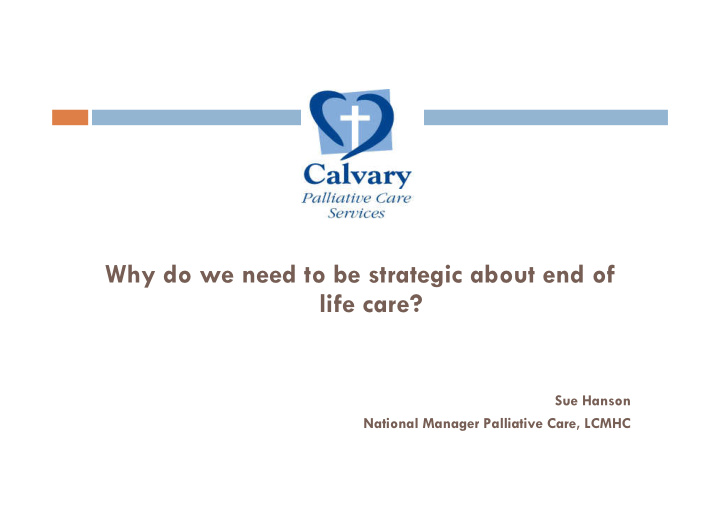



Why do we need to be strategic about end of life care? Sue Hanson National Manager Palliative Care, LCMHC
What is ‘strategic’? • NOT Business or operational planning • Address the biggest and most momentous decisions • The kind that will affect the direction for service and policy development for years to come • May lead to substantially different organisational structures for the provision of PEoLC • May lead to major changes in the relationships between key stakeholders • ‘Strategic elephants’
Thinking strategically The difficulty lies not so much in developing new ideas as in escaping from the old ones.” John Maynard Keynes
Breaking the frames
The reasons why we need to think differently? By 2056 the Australian death rate will more than double to 320,000 1 pa 51% of all deaths in those aged 80+ 2 400% increase in the number of people over 85 years ‘Tsunami’ of people with dementia 88% of those aged 65+ had three or more long term chronic illnesses 3 12% of the population aged >65 account for one third of admissions and half total bed days in acute care
Looking at care at the end of life through different frames � 1:5 people whose death was expected were seen by a SPCS 1 (approx 20,000:145,000 per year) � 85% English speaking 2 � 2/3rds born in either Australia or England 2 � 83% have a diagnosis of cancer 2 � In 2009-10 245 Indigenous people seen by SPCS 2 � 88% of residents left RAC due to death 3 17% had stayed less than 3 months 19% between three months and one year � About 50% of all deaths occur in acute care settings
National and State Key Strategic Directions National State & Territory Education and training for generalists � � Improve appreciation of death � Workforce development and dying as normal Establish state-wide clinical networks � Explore new roles � � Enhance awareness of benefits of Implement standards, research, evidence � access to palliative care based practice Consistent approaches to admission � Ensure appropriate and effective � criteria, bereavement, care planning palliative care is available to all Improve data availability & quality � based on need Review funding � � Support collaborative, proactive Service planning � effective governance of national Strengthen primary palliative care � Implement RDF and strengthen SPCS palliative care resources � Develop services – ATSI and CALD, � � Build and enhance the capacity of Bereavement , Pediatrics, SPCS Consult, Respite all relevant sectors to provide Strengthen capacity and capability in � quality palliative care RACF, community, acute care
Barriers to effective strategic planning 1 Attempting to predict the future 1. Reinforcing personal biases 2. Seeing what you want to see 3. Seeing what others want you to see 4.
Attempting to predict the future
Reinforcing personal biases
Seeing what you want to see
Seeing what others want you to see
Planning for the future Think strategically Incremental planning not appropriate in times of reform Think differently More of the same will not be enough Put people at the centre It is what they need not what we do that should be central Know more about the needs and care of people as they approach the end of their life. Be inclusive of all people, regardless of their location or setting Organise for quality Focus on boundary issues, patient journey and continuity of care
In conclusion? Winston Churchill once said: “If you don’t stand and fight when you have a chance to win, ONE DAY, you may be asked to go and fight when you have no chance”.
Thank you
Recommend
More recommend